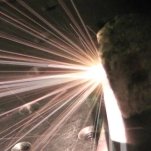Solar power could help save the planet as we know it through reducing greenhouse gas emissions. It might also be called upon to help blast asteroids that threaten us with obliteration.
Earth has long been peppered by meteorites and debris from space, but much of what actually hits the surface have been tiny fragments. When larger bodies have impacted, the results sometimes changed the planet. It’s thought the last major extinction event 65 million years ago, known as the “Fifth Great Extinction”, was possibly caused by the impact of a comet; the effects of which interfered with Earth’s ecosystem.
Even in modern times, impacts or explosions close to the surface of the planet have devastated large areas. The Tunguska Event in Russia in 1908 is believed to have been the result of an air burst of a large meteoroid or comet fragment. According to Wikipedia, the associated energy of the blast was around 1,000 times more powerful than the atomic bomb dropped on Hiroshima, Japan.
The Tunguska explosion bowled over an estimated 80 million trees covering 2,150 square kilometres.
Such devastation doesn’t need to involve huge bodies. It’s estimated a stony meteoroid of about 10 metres in diameter can produce an explosion of around 20 kilotons. The Tunguska object, depending on which study you read, is thought to have been around 50 – 100 meters in diameter.
So are we entirely at the mercy of these events? Pretty much so currently, except for a network of early warning systems that may allow for evacuation of an area before an event occurs – assuming the chunk of rock is small enough that there is somewhere safe to run to.
We may not always be so prone. It’s the stuff of sci-fi still, but one day we might intercept these asteroids and blast them before they reach us.
Nuclear missiles have of course been examined as an option, but engineers at the University of Strathclyde in Glasgow are also developing a technique based on solar powered lasers to add to an arsenal of asteroid deflection technology.
Dr Massimiliano Vasile of Strathclyde University’s Department of Mechanical and Aerospace Engineering; leader of the research, explains: “The approach we are developing would involve sending small satellites, capable of flying in formation with the asteroid and firing their lasers targeting the asteroid at close range.”
The damage to the asteroid would be inflicted in such a way to send it off course, away from the Earth.
“Our system is scalable, a larger asteroid would require adding one or more spacecraft to the flotilla, and intrinsically redundant – if one spacecraft fails the others can continue.”
Dr. Vasile says the concept may also have applications in clearing the growing amount of space junk humanity has left in space that now orbits the earth. Some of the debris poses a threat not only to operating satellites and other space vehicles, but to our own environment. In 2008, the US Navy fired a missile to destroy an out of control spy satellite in order to prevent its fuel tank crashing to Earth and releasing highly toxic hydrazine.
It’s not clear from the news release the nature of the lasers or of how solar energy would be harvested and stored to power them. In a previous and similar concept also associated with Dr. Vasile; small satellites equipped with mirrors called “mirror bees” would rendezvous with an asteroid then focus their mirrors on a specific point, vaporizing the area and releasing a stream of gases that would move the asteroid off course and out of harm’s way.












































